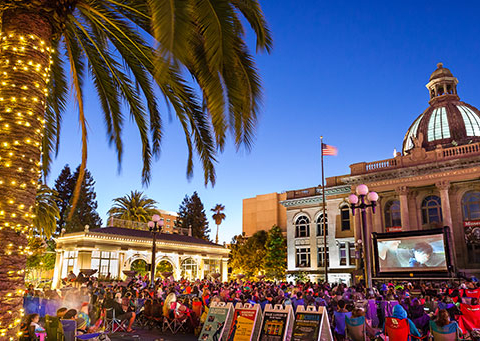By Jim Clifford
St. Patrick’s Day is celebrated March 17, so let’s salute General Patrick Edward Connor, an Irish-born Civil War-era soldier who is famous, or infamous, in military history books but little known in Redwood City where his family lived.
The Connors once occupied the Lathrop House, now located on Hamilton Street adjacent to both the San Mateo County Government Center and the history museum. There are plans for moving the house, a prime example of Steamboat Gothic architecture, to the parking lot behind the museum.
The structure is no stranger to being moved. Built in 1863, the 11-room, gabled mansion was initially located near the site of the present Fox Theatre. It was relocated in the 1890s but remained in the same general area until 1905, when It was moved again — this time to its present location. Connor purchased the home in 1870 and owned it until 1894, when the school district bought the site for the Central Grammar School that opened in 1895.
Despite Connor’s military accomplishments, the name of a civilian outranks his locally: Benjamin G. Lathrop, the first clerk, recorder, and assessor of San Mateo County. Conner even takes second billing to the third owner of the house, Sheriff Joel Mansfield, who joked that the mansion, now on the National Register of Historic Places, should bear the Mansfield name. After all, he owned it longer than Lathrop.
While he goes largely unnoticed in local histories, Connor is prominent in books about the West. He is noted in such works as “Bury My Heart at Wounded Knee,” “Men to Match My Mountains” and “American Military History,” a thick volume published by the United States Army.
Connor, who married Johanna Connor (no relation until their marriage) of Redwood City, fought in the Mexican War and then battled Arapahos in Utah, where he is buried. He developed silver mines in both Utah and Nevada, but it as a soldier that he will be remembered, mainly for his role in the Battle of Bear River in Idaho on January 29, 1863. When the gunfire stopped, 21 soldiers and 350 Shoshone were dead, including 90 women and children.
“Undisciplined soldiers went through the Indian village raping women and using axes to bash in the heads of women and children who were already dying of wounds,” Utah historian Brigham Madsen wrote in “The Shoshone Frontier and the Bear River Massacre.”
Slaughter was not unknown in the war for the West. In her memoir, Connor’s daughter, Kate, said her mother “came across a devastated camp where the Indians had killed all. A baby’s head was bashed against a wagon wheel.”
The Redwood City house is mentioned in Kate’s memoir. She called the residence a “seven gabled” house where, at 14, she fell into a nearby waterway. Almost nothing was known of the Connor family’s years in Redwood City until the 1931 memoir by Kate, then Mrs. Bartley Oliver, surfaced during her descendants’ search for their roots.
The Connors lived in Redwood City many years, Kate wrote, without saying just how many. The memoir states that Kate was four years old when the family moved from Utah to San Francisco, but the weather in San Francisco did not agree with her mother. As a result, the family moved to warmer Redwood City where Kate was married in 1884 at St. Mary’s Catholic Church. Her brother, Hillary, was born during the time in Redwood City.
Interestingly, a 1928 feature story in the Redwood City Standard made more of the Connor connection than it did of Lathrop’s. The home was “Redwood City’s most imposing residence – this house of many gables with its well-kept grounds, its flowers and fruit and shade trees, a place of beauty and comfort, with all that wealth could provide.” The writer said the doors of the Connor home were always open “to all, with a welcome that was genuine and generous.”






